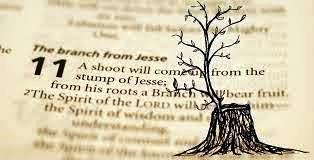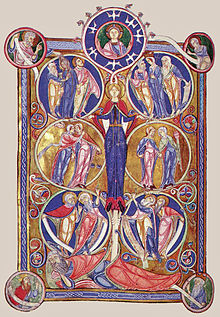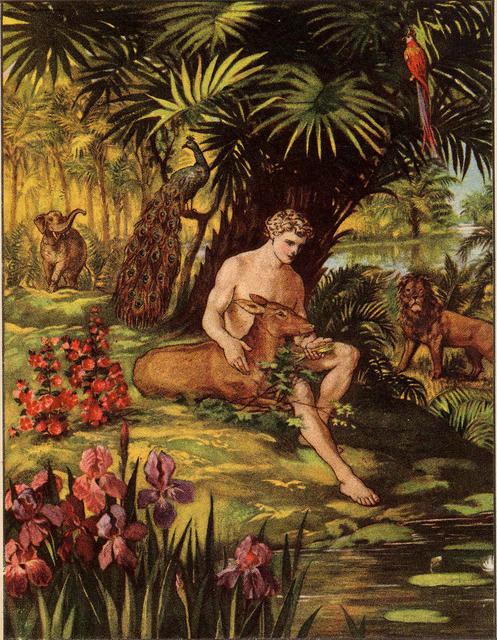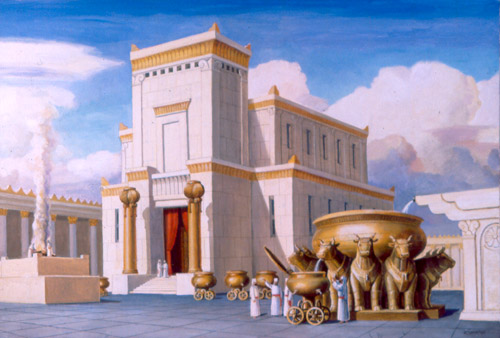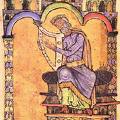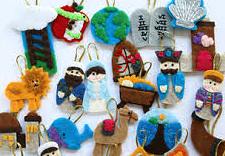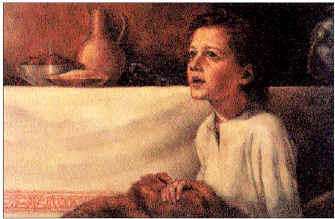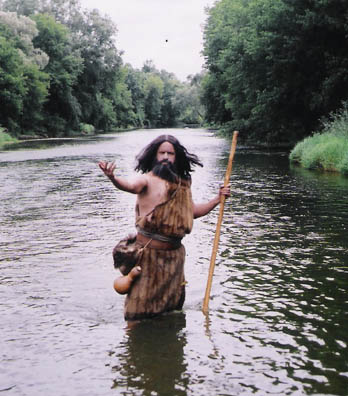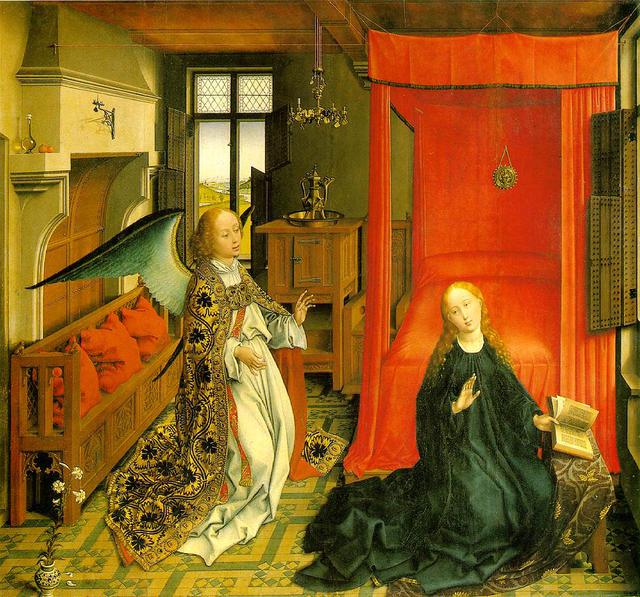THE JESSE TREE
THE SIGNIFICANCE OF THE JESSE TREE
During Advent I think we tend to look forward to the coming events such as the birth of the Saviour and events in the future of our lives such as death and judgment. And rightly so.
The beginning of the Matthean Gospel suggests there is also another way, looking back and reflecting how God has been preparing for the coming of His Son into this world. So another way of keeping Advent is to dress a Jesse Tree by adding a symbol daily to a branch. Each symbol represents an aspect of God’s salvific work beginning with God separating light from darkness. Even if we do not want to erect a Jesse Tree, the biblical readings for each day will also be a guide for contemplation and preparation for the coming of the Saviour of the world.
The words signify a small, tender product; a shoot, that is personified and thus refers to a person. In context it means:
He comes forth out of the stem of Jesse after the royal family was cut down and almost levelled to the ground during the Exile time and afterwards, but it would sprout again.
The prophet, Isaiah, had described the destruction of the Assyrian army under the image of a mighty forest, consisting of flourishing trees growing thick together, and of a great height; of Lebanon itself crowned with lofty cedars, but cut down and laid level with the ground by the axe wielded by the hand of some powerful and illustrious agent. In opposition to this image, he represents the great Person who makes the subject of this chapter as a slender twig shooting out from the trunk of an old tree, cut down, lopped to the very root, and decayed; which tender plant, so weak in appearance, should nevertheless become fruitful and prosper.
Both the Matthean and Lucan Gospels have a genealogy. As mentioned Matthew begins with, “The book of the generation of Jesus Christ, the Son of David, the son of Abraham” whilst Luke has his after the baptism by John and he traces Jesus’ genealogy back to Adam.
From Isaiah 11.1, Matthew, Ch.1 and Luke Ch.3 came the idea at least from mediæval times to depict the ancestry of Jesus through a root that grew into a tree, the Jesse Tree from Adam to Mary who gives birth to the Saviour.
But why a Jesse Tree? It is named after the father of King David, Jesse, who lives in Bethlehem and Christians have interpreted other passages from Isaiah that the Messiah would come . e.g 7.14 “the virgin ( although the Hebrew speaks of a young woman) will give birth unto a child and his name will be called Emmanuel.”
Another passage is:
9. 6, “For unto us a Child is born, a Son is given and the government shall be upon his shoulder, and his name shall be called, Wonderful, Counsellor, the mighty God, the everlasting Father, the Prince of Peace.”
In Mediæval art and stained glass windows, beginning from the 11thC. reveal a tree rising from Jesse of Bethlehem, the father of king David. In the Vysehrad Codex, the 11thC Ms. from Prague, the Jesse Tree is depicted in a literal way. The prophet, Isaiah, approaches Jesse from beneath whose feet is springing a tree, and wraps around him a banner with words that translate literally, "A little rod from Jesse gives rise to a splendid flower".
In the Lambeth Bible, dated between 1140 and 1150, the Jesse Tree illustration comes at the start of Isaiah and differs greatly from the earlier one, having much more the form that is familiar from both manuscript and stained- glass versions. In it, Jesse lies at the border of the page with the tree springing from his side. The branches of the tree are depicted as highly formalised circular tendrils, which enclose six pairs or trios of figures. At the centre, tall and highly stylised in the same manner as 12th-century columnar statues, stands a full length Blessed Virgin Mary from whose head spring tendrils which enclose a bust of her Son, Jesus. He is encircled by the seven doves, with outspread wings; this became the usual depiction of them. Four Prophets with scrolls occupy medallions in the corners.
In stained glass windows the earliest was in Chartres. Among the famous stained- glass windows of Chartres Cathedral in Northern France is the Jesse Tree window, of 1140-50. In the lowest central panel reclines the figure of Jesse, with the tree rising from his middle. In each of the seven sections it branches out into a regular pattern of scrolling branches, each bearing a bunch of leaves that take on the heraldic form of the Fleur de Lys, very common in French stained glass. Central to each panel is a figure:- David, Solomon, two more crowned figures, Mary (mother of Jesus) and, surrounded by the doves bearing the gifts of the Spirit, a majestic figure of Christ, larger than the rest. In each of the narrower panels, edged by richly patterned borders, are the figures of fourteen prophets bearing scrolls.
SYMBOLS FOR DRESSING THE JESSE TREE FOR EACH DAY OF ADVENT.
Now we shall look at each day briefly, but I would like to encourage you to treat each reading in the Ignatian way, that is, trying to imagine each scene and making it alive for you.
1st December – Genesis. 1.1-31, 2.1-4
God s act of creation begins with light when He separated this from darkness. So God’s light is different from that that comes from the sun, stars and moon. That is one of the significant statements in the bible and it will become important in the Johannine Gospel. Afterwards He made the stars, sun, moon, the sea, land, animals, fish and man. All that God made was good – it was very good. It would seem from the first chapter in Genesis God did all of this for man whom He made in His own image. God then trusted man to look after it all. It would seem God had appointed man as His lieutenant.
Symbols could be animals, man, stars, sun, moon.
2nd December – Genesis 2. 7-9, 18-24
The 2nd account of creation is older than the first account – here God has made Eden, a paradise for man created from the dust in which to live. God took a rib from the man to make a companion for him. All the fruits in the garden are at their disposal except one – the tree of the knowledge of good and evil. Both Adam and Eve have the potential for everlasting life in this beautiful, perfect world.
Symbols could be trees, fruits, man or woman
3rd December – Genesis 3. 1-7, 23-4.
The Fall of Man – Adam and Eve are beguiled by the serpent to know everything as God does. At that moment, they realise their sin of disobedience to God and try to hide their act. One can never hide from God as Psalm 139 makes abundantly clear. God finds them and punished them by expelling them from the garden and having to work to survive. Seraphim and Cherubim guard Paradise. However God makes a promise – the seed of Eve shall bruise the serpent’s heel. In the meantime the whole of creation will groan until redeemed by Christ.
Symbols could be a serpent, tree, apple having been bitten,
4th December – Genesis 6.5-8, 13-22, 7.17,23, 24; 8.1, 6-22.
The building of the ark by Noah and the destruction of the world. Mankind has sinned so greatly that God wants to start again. To accomplish this He directs Noah to build the ark to house his family and a pair of all animals and birds. After God destroys the world with rain falling continually for forty days, He starts again. God declares that He will not destroy the earth again and to reveal His promise he makes a rainbow. That rainbow announces that God will never again destroy the earth, and whenever we see one that is what we should remember.
Symbols, rainbow, dove, animals, flood.
5th December – Genesis Ch.12ff.
The calling of Abraham to be the father of a great nation. The covenant God makes with him is that his seed shall inherit a land and his descendants will be more numerous than the stars in heaven. The original sign of this covenant was the traditional one of offering up sacrifices. Later on, the sign would be circumcision according to the Priestly source. He becomes the model of faith in leaving his land to follow God’s calling and of his righteousness, especially prominent in Paul’s letters.
Symbols could be a map, a desert, water, even stars.
6th December –Genesis 22.1-14
Isaac – Sarah eventually bears Abraham a son that has been promised by God. Then God asks Abraham to sacrifice this son, and the two with a servant journey to Mt. Moriah. Isaac is bound and placed on the altar. As Abraham raises his arm to kill his son, an angel releases Abraham from sacrificing Isaac and instead a ram is caught in a thicket. Isaac lives, marries Rebekah and the younger son Jacob by deception involving his mother receives his father’s blessing rather than the rightful son, Esau, the elder.
Symbols could be wood, a knife, a ram.
7th December – Genesis Ch.25 ff.
Jacob - After receiving his father’s blessing he also is instructed to marry one of their kinsman as Isaac had been. Jacob travels to Haran. On the way he rests his head on a stone at night during which he dreams of angels descending and ascending a ladder. During that dream, the Lord stood before him renewing the covenant he had made with Abraham. The next morning he utters those unforgettable words, “Surely God was in this place and I did not know it. … How dreadful is this place. This is none other than the house of God, and this is the gate of heaven.” Yet it does not change his deceitful ways. He continues on his journey and at a well sees the lovely Rachael who takes him to her father, Laban. Most of the Jacob saga is one of deception, on his part and on Laban’s. After eventually fleeing from Laban, there is that moment that changes Jacob’s life completely. At night, he struggles with another and in that struggle his thigh is put out of joint. He is of course struggling with God who at the break of day, instructs Jacob that henceforth his name will be Israel. From that point on, there is no more deception and Jacob’s sons will become the twelve tribes of Israel.
Symbols could be a ladder, a meat dish, flock of sheep
8th December – Genesis 37.23-38; 45. 3ff
Joseph - He is the link between the patriarchal saga and the Jacob’s descendants living in Egypt, the backdrop for the Exodus epic. He proves to be an upright character, despite what his brothers did to him out of jealousy. Through seven years of famine after seven years of plenty that Joseph had interpreted from a Pharaoh’s dream, he was appointed Vizier in Egypt and was able to handle the famine crisis. Outside of Egypt others also suffered famine, including Canaan and so some of Joseph’s brothers came to buy grain. That eventually led to the old Jacob, Israel, journeying to Egypt with his family and all his possessions and above all to be united with Joseph.
Symbols could be a well, bags of wheat, silver coins.
9th December – Exodus Ch.3ff.
Moses and Exodus – A time came in Egypt that the Pharaoh did not remember Joseph and they were burdened hard. Eventually Moses came to their rescue through Yahweh’s intervention, beginning with Moses’ experience of the burning bush and being on holy ground where Yahweh’s intentions are given to Moses. This eventually leads to his’ going to Pharaoh with his articulate brother, to let his people go. Pharaoh is reluctant. Plagues are sent and eventually Pharaoh agrees, at first. What we know as the Pass- over is enacted when the blood of the sacrifice of the lamb is placed on the Hebrew’s doors so the angel of death will pass by and the first-born will not be slain as happened in the rest of Egypt from the Pharaoh’s household down. They must eat the meal of roast lamb and unleavened bread in haste in preparation to flee.
Pharaoh changes his mind as the Hebrews set out to leave. The climax comes at the crossing of the Reed Sea when Yahweh’s children are pursued as they plunge into the dry crossing. The description in Exodus is very powerful when God drove the waters to either side to let the Hebrew children through and then how the waters returned and drowned the Egyptians and their chariots. This is followed by the covenant at Mt. Sinai. On Mt. Sinai, Moses came to know the presence of the Lord in a very special way.
Symbols could be rushes, unleavened bread, roast lamb, tablet of the law.
10th December – I Samuel 3. 1-18
The calling of Samuel – Hannah in thanksgiving for a son gives him to the Lord, takings him to the shrine of Shiloh and places him in the care of the old priest, Eli. Sanuel hears a voice and thinks it is Eli calling. It is repeated and Eli realising it is the Lord, tells Samuel, to answer, “Speak Lord for thy servant heareth.” Next time when Samuel hears this voice he does what he has been told and God reveals His plan.
Samuel proves to be faithful to the Lord. Eventually when the people demand a king, Samuel is very reluctant but listens to the Lord who leads him to Saul, son of Kish and anoints him. Thus begins the monarchy in Israel. He will also anoint David, son of Jesse.
Symbols could be a lamp, temple, a listening ear.
12th December – I Samuel 17 - 12-51
David – He is the hero despite all his sins and failures. He is the One that all Jews see as God’s favourite. Why is this? So many legends grew up about him such as his encounter as a boy with Goliath. Yet David had many blemishes and perhaps Psalm 51 sums up his contrition. “Have mercy upon me for my great sin. Against thee only have I sinned and done this evil in thy sight. Create in me a clean heart O Lord.” Despite all his failures as a parent and his other sins of murder and adultery, he is the one looked upon as the Lord’s truly anointed and from his stock the Anointed will come. Isn’t it interesting how often God used sinful people in the Old Testament and continues to do so?
Symbols could be star of David, sling, harp.
13th December – I Kings 3. 5-28
Solomon – David’s son and under his rule the expansion of the kingdom was at its greatest. At the beginning of his reign God offered him one gift and the king chose Wisdom. We are told that his wisdom went before him and even the Queen of Sheba came to visit him as a result. Later on in his reign he allowed his foreign wives to worship foreign gods and so his own heart was not perfect with the Lord I Kgs.11.4. After he dies so does the uniting of the Twelve tribes, with the formation of the two kingdoms.
Symbols could be a crown, Queen of Sheba, a scale.
14th December – Matthew 1.18-25
Joseph - is the husband of Mary, a descendant of the house of David. In a dream God reveals to him that the Child Mary is carrying is the Holy One of Israel who is the Saviour of the world. Therefore take Mary to be your wife and so legally Jesus is the child of his, of the house of David. In another dream, he is told to flee with Mary and the Child away from Herod.
Symbols could be a hammer, saw, nail.
15th December – Luke 1.26- 38
Mary – is to be the mother of Jesus the Christ as she learns from the Archangel Gabriel’s visit. In Luke’s gospel she is portrayed the perfect disciple as she hears the Word of God and heeds it. “Be it unto me according to thy word.” Her fiat, prepares for God’s greatest work on earth. Afterwards she visits her aged cousin Elizabeth who recognises her as the mother of her Lord and she proclaims God’s greatness in what we know as the Magnificat.
Symbols could be an angel, a prayer book, a lily
16th December – Luke 1.1ff Mark 1.1 -10
John the Baptist –is the cousin of Jesus who is born to the aged Elizabeth and Zachary. He is the forerunner and announces the coming of the Son of God on the banks of the Jordan. He also preaches the message of repentance and baptises, even Jesus in Mark and Matthew’s gospels. Yet he knew that “I must decrease and he must increase.” As well in the Johannine gospel he recognises Jesus as the Lamb of God who will take away the sin of the world.
Symbols could be a river, a rough-looking coat, a crook.
17th – 24th Advent In the Church’s readings it is count down until Christmass and all reading begin to look forward. They also have the “O” Antiphons that give us a special way to ponder on the coming of the Anointed One who was given various titles in the Old Testament.
17th December – Wisdom 8.1 Prov. 3.19, 8.22.
O Sapienta - Wisdom - Sophia – the Word - Wisdom orders all things – Wis. 8.1 The Lord by Wisdom has founded the earth Prov.3.19 – Blessed is the one who finds wisdom, and the one who gets understanding, for the gain from her is better than gain from silver and her profit better than gold. She is more precious than jewels, and nothing you desire can compare with her. Long life is in her right hand; in her left hand are riches and honour. Her ways are ways of pleasantness, and all her paths are peace. Proverbs 3.13-18.
The Wisdom books personify Wisdom often. In Sirach/ Ecclesiasticus, the teaching of Jeshua ben Sira to his students is full of the importance of wisdom in living a virtuous life and of Wisdom herself. One of the most beautiful passages in Holy Writ is Ch. 24 from this book.
Wisdom shall praise herself, and shall glory in the midst of her people.
In the congregation of the most High shall she open her mouth, and triumph before his power.
I came out of the mouth of the most High, and covered the earth as a cloud.
I dwelt in high places, and my throne is in a cloudy pillar.
I alone compassed the circuit of heaven, and walked in the bottom of the deep.
In the waves of the sea and in all the earth, and in every people and nation, I got a possession.
With all these I sought rest: and in whose inheritance shall I abide?
So the Creator of all things gave me a commandment, and he that made me caused my tabernacle to rest, and said, Let thy dwelling be in Jacob, and thine inheritance in Israel.
He created me from the beginning before the world, and I shall never fail.
In the holy tabernacle I served before him; and so was I established in Sion.
Likewise in the beloved city he gave me rest, and in Jerusalem was my power.
And I took root in an honourable people, even in the portion of the Lord's inheritance.
I was exalted like a cedar in Libanus, and as a cypress tree upon the mountains of Hermon.
I was exalted like a palm tree in En-gaddi, and as a rose plant in Jericho, as a fair olive tree in a pleasant field, and grew up as a plane tree by the water.
[I gave a sweet smell like cinnamon and aspalathus, and I yielded a pleasant odour like the best myrrh, as galbanum, and onyx, and sweet storax, and as the fume of frankincense in the tabernacle.
As the turpentine tree I stretched out my branches, and my branches are the branches of honour and grace.
As the vine brought I forth pleasant savour, and my flowers are the fruit of honour and riches.]
I am the mother of fair love, and fear, and knowledge, and holy hope: I therefore, being eternal, am given to all my children which are named of him.
Come unto me, all ye that be desirous of me, and fill yourselves with my fruits.
For my memorial is sweeter than honey, and mine inheritance than the honeycomb.
They that eat me shall yet be hungry, and they that drink me shall yet be thirsty.
He that obeyeth me shall never be confounded, and they that work by me shall not do amiss.
[All these things are the book of the covenant of the most high God, even the law which Moses commanded for an heritage unto the congregations of Jacob.
Faint not to be strong in the Lord; that he may confirm you, cleave unto him: for the Lord Almighty is God alone, and beside him there is no other Saviour.
He filleth all things with his wisdom, as Phison and as Tigris in the time of the new fruits.
He maketh the understanding to abound like Euphrates, and as Jordan in the time of the harvest.
He maketh the doctrine of knowledge appear as the light, and as Geon in the time of vintage.
The first man knew her not perfectly: no more shall the last find her out.]
For her thoughts are more than the sea, and her counsels profounder than the great deep.
I also came out as a brook from a river, and as a conduit into a garden.
I said, I will water my best garden, and will water abundantly my garden bed: and, lo, my brook became a river, and my river became a sea.
I will yet make doctrine to shine as the morning, and will send forth her light afar off.
I will yet pour out doctrine as prophecy, and leave it to all ages for ever.
Behold that I have not laboured for myself only, but for all them that seek wisdom.
Wisdom is there from the beginning. Even though Wisdom is personified as Sophia, it is feminine in the Greek. As such it is personifying the Word. So we read, “In the silence of the night thy Word swiftly came down. Wis.18.14. Then in in the Johannine Gospel , “In the beginning was the Word and the Word was with God … and became flesh (Prologue).
Symbols could be the bible, a light
18th December - Exodus 3. 20.1
O Adonai – The Lord – Moses when he saw the burning bush that is not consumed he knew this was extraordinary. As he approached, he was told not to come too close and to take off his shoes as he was on holy ground. Here Adonai revealed that He is the Lord who will rescue His people Ex. 3.2ff.
For the LORD is our judge, the LORD is our lawgiver, the LORD is our king; he will save us (Isa. 33.22) we read. It is looking back on Mt. Sinai and the giving of the Law to Moses. In the N.T. Jesus tells us He has come to fulfil the Law. In other words, He is the Law, very explicit in the Johannine Gospel.
Symbols could be the burning bush, Mt. Sinai, the Tablets.
19th December –Isaiah 11.1-3.
O Radix Jesse – Root/Shoot of Jesse or as some translations have it – flower of Jesse. Whichever way, it denotes life. In the mediæval illustrations they always show a tree springing forth from its stump. The Anointed one is going to bring life, a new life that is seen in the birth of the Christ. It is the beginning of a new creation that will renew all things. As Paul tells us, creation was groaning until the coming of Christ.
Symbols could be a shoot, plant, flower.
20th December – Isaiah 22.22
O Clavis David – Key of David – Only he of the house of David can open and shut. When it is shut none can ever open again. It is the Anointed one, the Chosen One, only he is given this key. When that key opens, it will be for a new life. Those who believe in Him will enter and experience eternal life now.
Symbols could be a key, a closed door.
21st December – Psalm 19.6-7
O Oriens - O Day Spring. For those who pray the Morning Office we offer words like these in the Benedictus, “Whereby the day-spring from on high has visited us to give light to those who sit in darkness and in the shadow of death and to give light to those who sit in darkness.” The rising sun of each day will dispel the darkness of the night. That is a positive thought for each morning. Biblically light always follows darkness. Remember God created evening first that was followed by day. The coming of the Anointed One will be “the Light of the World” and in that light we shall be continually judged.
Symbols could be the rising sun, lamp, candle
22nd December – Psalm 2.7-8
O Rex Gentium – King of the Gentiles – Psalm Two tells us that the Lord welcomes all even to the end of the world. The greatest of all the apostles makes clear that he was appointed to preach to the Gentiles. And we must not forget that Abraham was called to be the Father of many nations as Paul points out in his letter to the Romans Gen 17.5; Rom.4.17.
Symbols could be people of a different colour, a crown, sceptre.
23rd December – Isaiah 7.14, 33.22
O Emmanuel – God with us. When Joseph had his dream he is told that Mary’s Child will be called Emmanuel. Sometimes I think Christians forget that God is with us always. We are never alone. That is the important message of the Incarnation. The Word made His tent amongst us. He is not remote. The Anointed One lives within us, closer than our breathing.
Symbols could be The Good Shepherd picture or any picture of Christ
24th December – Luke 2.7ff
O Virgo Virginum - The Virgin Mary gave birth to the Saviour of the World. More importantly she taught us about being the vessel of God to work within us. Pondering on our Lady often will always direct us to her Son, now our High Priest in Heaven making intercessions for us to His Father.
Symbols could be a crib, a star, shepherds
There are some who commemorate this day as Lux Mundi - John 1. 9 – the Light of the World - This too is worth pondering on. “He is the light that comes into this world but the darkness comprehended it not.” When we understand the Johannine Gospel correctly, we know that one of its main messages is to reveal that Christ came to destroy all darkness. But some such as the Pharisees decided they wanted to continue to live this way. Cp. With the man blind from birth. Knowing that all can be illuminated by the Anointed One is a blessing to those who love the Lord. They want to know the truth, but most of all the truth about themselves. As we approach the Nativity of Christ, it is imperative that we know ourselves as God does. If we do not, we are not much use to God and our welcome of His birth is shallow.
Symbols could be a candle, lamp.
Perhaps some of you would like to be creative this Advent and have a Jesse Tree but the important thing as I mentioned earlier is to ponder on what each symbol means in God’s salvific plan. Don’t forget even if you do not erect a tree, you can use the bible passages and use them as a source of preparation for Christmass, remembering that God’s plan for us was long in the planning.
Meditating on these passages I think it is a sure way to keep Advent when in the fullness of time God sent His only begotten son. We can learn so much from those God used in the preparation for His coming.
When we analyse Matthew’s genealogy we shall notice there are four women mentioned too, not above suspicion.
These were Tamar, Rahab, Ruth and the wife of Uriah, we know is Bathsheba and then Mary.
Tamar in Genesis ch. 39. Her father in-law had not done the right thing by her and she coerced him to do the right thing, which he finally recognises. It is this act that preserves the house of Judah.
Rahab – Joshua – Ch.2 – She allows the spies to escape on her condition she and her family are saved when Joshua supposedly destroys Jericho
Ruth – daughter in-law to Naomi – who eggs on Boaz through her mother in-law.
Bathsheba – more sinned against it would appear to satisfy David’s lust. II Sam.11. 2ff.
Whatever they have all been compromised. Again, it shows how God uses sinful people for His work of salvation fulfilled in the birth of Jesus and then His death, resurrection and ascension.
